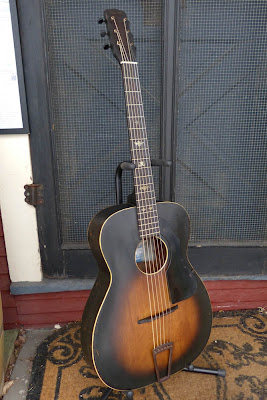c.1935 Harmony-made Supertone Roundhole Archtop Guitar
This guitar bears a Supertone (Sears) brand name in the soundhole but it's obviously a Harmony make. Sometimes these have Harmony-style date stamps in them but this one doesn't. Still, it was probably built around 1930-35. This type of Harmony guitar seems to have been based on the early Martin archtops of the same time as they're around the same dimensions and body shape as the early archtop Martins and share their round soundholes.
Unlike a Martin, though, this is a much more budget guitar: the woods are all-solid but the body is all birch and has a pressed (rather than carved) top, the neck is made from poplar, and the fretboard and bridge appear to be some sort of dyed hardwood (typical). The binding is real celluloid but the fret markers are painted-on stencils.
After all the work was done on this guitar, it's come out an extremely loud, vibrant, and punchy instrument. It cuts really well and has a good, full, swing-era tone. I think in the hands of a swing guitarist or gypsy-jazz guitarist this would really shine, but it does the blues and "old country" as well.
The only unoriginal parts on this are this new bone nut and a replacement endpin. Check out the extremely faded Supertone label at the headstock's top. This has a modern-feeling 1 11/16" nut width which means the bigger, v-shaped neck is still quite comfortable playing chords and lead up and down the length of it.
This is roughly 00-size.
The guitar had some previous "work" done to it including some workmanly but messy seam repairs and a neck reset, but there was much to be done! I had to reglue all the top braces as they were loose on the bass side, recut a botched setup job on the bridge, cleat and glue up a couple top cracks and fill a back crack, reglue some side seams, lube the tuners, level and dress the frets, make and install a new nut, raise the tailpiece, and of course clean and set it all up.
Just FYI, the top bracing is curious in that it's "banding" instead of more typical braces. They're thin and wider like extra-wide bridge plates.
Original frets leveled out nicely.
This original, non-adjustable bridge had been cut down and messed-about before I fixed the guitar. I had to fill some too-deep slots, reprofile it, and then recut the slots for proper action.
And speaking of action -- it's spot-on and quick, 1/16" on the treble and 3/32" on the bass at the 12th fret. This guitar has a longer (for the time) 25 1/8" scale which means that, with the unreinforced neck and light build, a set of 50w-11s sounds and feels just right, though this would probably do alright with 12s as well.
Bound soundhole and top edge with a fun, cutout pickguard.
The tailpiece, and the finish for that matter, is pretty distressed but also looks very cool with all that wear. Note that I had to raise the mounting on this tailpiece a little bit to keep the bottom of it off the top when the strings are at tension. Generally, if the bottom of trapeze tailpieces rests on the top at all, the guitar develops all sorts of ugly buzzing at the tailpiece.
Black-finished sides and two-tone sunburst top and back.
These original tuners lubed up just fine and work well.
Replacement old plastic endpin.
Here's the slightly washed-out label in the soundhole.
















Comments